
Johannes
Hermandus Julius
Kayser was born in Harlingen (Fr) in 1842. About his youth nothing is
known. Nor seems the actual spelling of his familyname to be known;
several documents refer to him as Kaijser, while in other older sources
the name Keyzer can be found.
In the late 1850's he became an overseer at P.J.H. Cuypers' restoration
of the St. Servaas in Maastricht. At Cuypers' office in Roermond he
learned the further skills of architecture. In the early 1870's he
became an autonomous architect. Especially in the field of churches he
became an important architect, but he also designed profane buildings.
While his churches are in neo-Gothic
styles mostly, his schools and town halls often are in other styles.
Although active in several parts of the country, Kayser built most of
his work in the province of Limburg. In 1873 he moved to Venlo, where
he was town architect until 1891. After that he returned to Maastricht.
In his first few years as a church architect Kayser found his
inspiration in early French Gothicism. In the late 1870's he exchanged
that influence for a new one, the North-German brick Gothicism. Typical
features of Kayser's work from then on are the deep niches in which are
the windows, the stepped gables and the use of glazed bricks. Elements
of this style return in much of his work in all of his career. This
North-German orientation sets Kayser apart from most of the others of
P.J.H. Cuypers' students.
Kayser died in 's-Hertogenbosch on March the 17th 1917. His son Jules
became an architect too and was also mostly active in Limburg.
The following is a list of Kayser's work. It's still incomplete.
1872-1873 Maastricht-St. Pieter (L): church H. Petrus
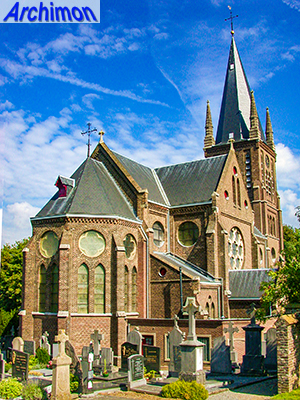
Kayser's first church. Three-aisled cruciform basilica. Square tower with corner turrets.
1873-1876 Sittard (L): pilgrims church O.L. Vrouw van het H. Hart
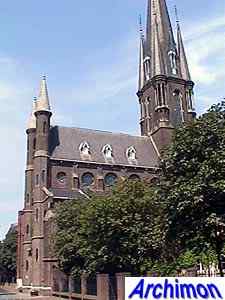
Church
in neo-Romanogothic
style, with big crossing-tower. Inside optimal use of space is made by
making galleries above the side-aisles.
1873-1874 Koningsbosch (L): convent Liefdezusters van het Kostbaar Bloed
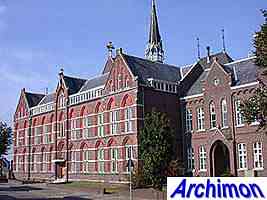
Complex in a combination of neo-Renaissance and neo-Gothic styles.
1875-1877 Oud-Caberg (L): church H. Hart van Jezus
Small one-aisled neo-Gothic church with short rectangular choir. Several changes later; tower designed by W. Sprenger added in 1900, choir altered by A.J.N. Boosten in 1936-1937.
1877-1878 Posterholt (L): church H. Matthias
Cruciform basilican church in neo-Gothic style, with square crossing tower and rectangular choir. Damaged in World War Two and demolished later.
1877-1878 Merkelbeek (L): church H. Clemens
Three-aisled hall-church resembling the Stufenhalle-type. Later a transept and new choir were added.
1878-1880 Reuver (L): church H. Lambertus
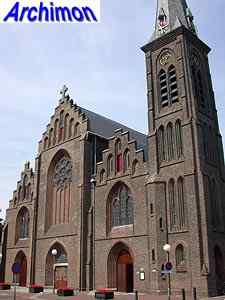
Kaysers first church inspired by North-German Gothicism. Three-aisled basilica, with a stepped gable at the front of each of the aisles. Tower next to the church, rectangular choir. In 1907 Kayser built a new nave square on the old one, that now serves as a transept. The northern transept-arm is demolished. Kayser's son Jules added a new northern side-aisle in 1923.
1878-1883 Herten (L): church H. Michaël
Three-aisled cruciform church in neo-Gothic style, inspired by North-German Gothicism. Stepped gables at the front and transept. Work didn't start until 1881. Tower not completed until 1893. Church destroyed in World War Two.
1878 Heerlen (L): town hall
Demolished. No further details.
1878-1879 Heerlen (L): chapel Savelbergconvent
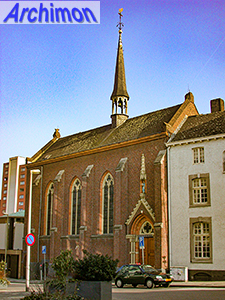
Chapel in neo-Gothic style.
1879 Venlo (L): restoration town hall
Kayser executed this restoration for which P.J.H. Cuypers provided the plans.
1880-1884 Venlo (L): public elementary school
Building in neo-Renaissance style. Kayser most important profane work.
1880-1881 Venlo (L): restoration monastery Transcedron and Collegium Albertinum
No further details.
1880-1884 Broekhuizenvorst (L): restoration church H. Naam Jezus
No further details.
1882 Meerssen (L): restoration church St. Bartholomeus
Executed under supervision of P.J.H. Cuypers. Repairs and renewal of details, new crossing-tower.
1882-1884 Rotterdam (ZH): church H. Verlosser en St. Barbara

Three-aisled cruciform church in neo-Gothic style, inspired by North-German Gothicism. Tower with corner-turrets. In the 1990's rebuilt into apartments, spire removed.
1882 Sambeek (NB): extension Redemptorist convent
New wing and chapel in neo-Gothic style.
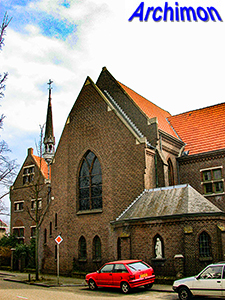
Square
complex with
chapel in neo-Gothic style.
1884-1885 Venray (L): town hall
Building in combined neo-Gothic and neo-renaissance styles, with stepped gables. Extended by Jules Kayser in 1925.
1884-1887 Holset (L): restoration church H.H. Lambertus en Genoveva
Included replacement of large parts of the walls and reconstruction of the Romanesque windows.
1885-1886 Broekhuizen (L): restoration church St. Nicolaas
No further details.
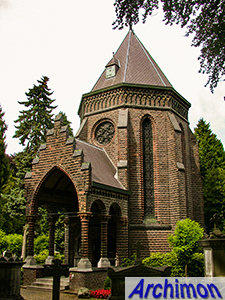
Octagonal chapel in neo-Gothic style.
1886 Smakt (L): church H. Jozef
Small three-aisled church without tower. Damaged in World War Two, repaired later but in 1967 demolished.
1886-1888 Wellerlooi (L): church H. Catharina
Small one-aisled church without tower. Stepped gables at the front and the back. Destroyed in World War Two.
1887-1888 Borgharen (L): church H. Cornelis
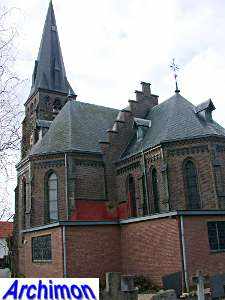
Cruciform basilican church in neo-Gothic style inspired by 13th-century French Gothicism. Frontal tower. Only church by Kayser with polygonally closed transept-arms. Transept and choir are seperated from each other by a stepped gable. Until 1979 named St. Martinus.
1887-1888 Holtum (L): church H. Martinus
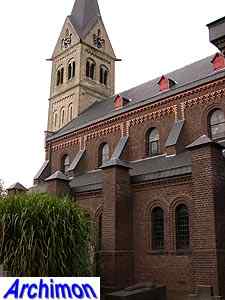
Three-aisled basilican church in neo-Romanesque style, incorporating a heightened medieval tower.
1887-1888 Rijckevoort (NB): church St. Rochus
One-aisled church in neo-Gothic style. Replaced a 16th-century chapel. Extended in 1927 by J. Franssen. Side-aisles and baptistry added by J. Strik in 1955. Spire simplified in ca. 1985.
1889 Schinveld (L): church H. Eligius
Three-aisled cruciform church in neo-Gothic style incorporating an older tower. The tower is replaced by Kayser in 1903.
1890-1895 Wittem (L): Redemptorist monastery
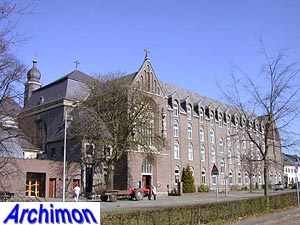
Complex in neo-Gothic style, incorporating a 18th-century Baroque church.
1890-1891 Altforst (G): church St. Donatus
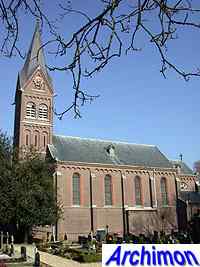
One-aisled church in neo-Romanesque style.
1890 Maasbracht (L): church H. Gertrudis
Three-aisled church in neo-Gothic style, inspired by North-German Gothicism, incorporating a Romanesque tower. Stepped gables at side-aisles, transept and choir. Rectangular choir with lateral chapels. Destroyed in 1944.
1890 Maastricht (L): chapel Ursuline convent
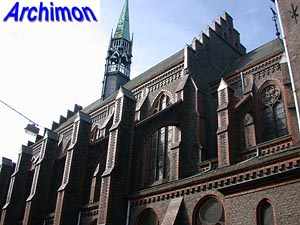
Basilical chapel in neo-Gothic style inspired by North-German Gothicism. Stepped gables at the front and back of the nave. Choir with ambulatory. Buttresses and flying buttresses support the building.
1890 Merselo (L): church H. Johannes de Doper
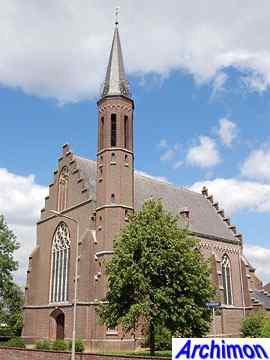
Most of the nave of a medieval chapel is replaced by a new one-aisled nave with stepped gables at the front and back. Octagonal stair-turret at the side.
1891-1892 Beek (G): enlargement church St. Bartholomeus
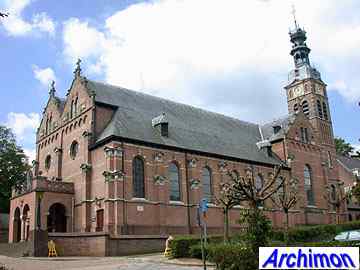
Enlargement in neo-Renaissance style of a church in neo-Classical style. Kayser added a fourth aisle and a pseudo-transept with tower.
1891-1893 Vaals (L): church H. Paulus Bekering
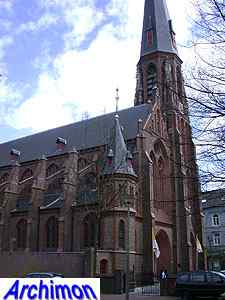
Three-aisled church in neo-Gothic style, inspired by North-German Gothic.
1895 Roermond (L): church Kapel in 't Zand
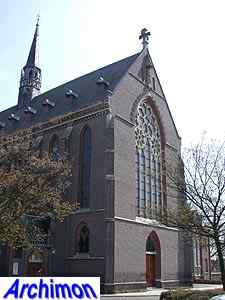
One-aisled church in neo-Gothic style. Originally the front had turrets at its corners, which were damaged by a storm in 1940. The original steeple was already damaged by storm in 1921 and replaced by a simpler version. Stepped gable between nave and choir.
1898 Schijndel (NB): chapel St. Jozef convent
Chapel in neo-Gothic style.
1899 Eijsden (L): school
Three storeys high building in neo-Renaissance style. Part of an Ursuline convent.
1899- 1900 Maastricht (L): church convent Onder de Bogen
Three-aisled cruciform church in neo-Gothic style.
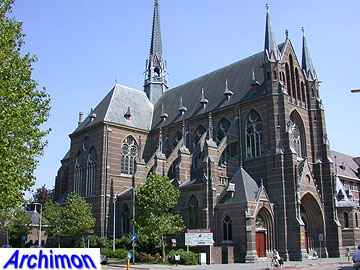
Big complex with church in neo-Gothic style.
1900-1901 Nijmegen (G): church Maria Geboorte
Three-aisled nave. The church is completed in 1923-1924 by Jules Kayser, who adds transept, choir and front.
1901-1903 Velp (NB): extension St. Alfonsis convent
New wing in sober neo-Gothic style.
1902 Boxmeer (NB): Hotel De Boomgaard
Building in neo-Renaissance style. Probably by Kayser.
1904 Sint-Michielsgestel (NB): villa Ruwenbergstraat 4
Former mayor's house. No further details.